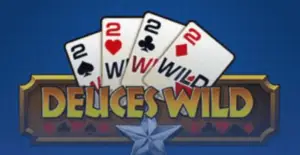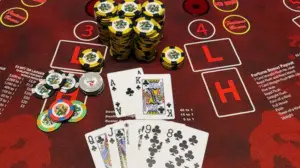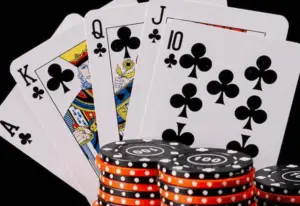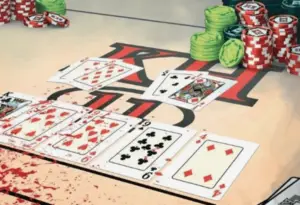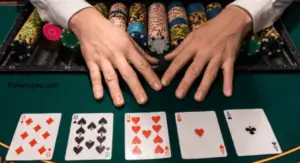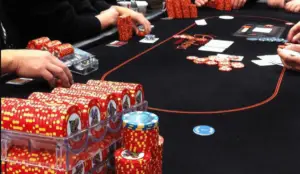5 Card Stud Poker is one of the earliest forms of poker, originating during the American Civil War in the 1860s. It is one of the most popular types of stud poker.
It was the most popular poker variant for over a century until it was surpassed by games like Texas Hold’em and Omaha in recent decades.
However, 5 Card Stud is still enjoyed today, especially in mixed game formats and in certain parts of the world like Finland where a specific variant called Sökö is played.
Basic Rules and Gameplay
5 Card Stud is typically played with a fixed limit betting structure and up to 8 players. The game begins with each player placing an ante, a small forced bet, into the pot before the cards are dealt.The dealer then distributes the cards to each player in the following manner:
First Round (1st Street): Each player receives 2 cards – 1 face-down (hole card) and 1 face-up (door card).
Second Round (2nd Street): Each player receives 1 face-up card.
Third Round (3rd Street): Each player receives 1 face-up card.
Fourth Round (4th Street): Each player receives 1 final face-up card.
After the first 2 cards are dealt, the player with the lowest valued door card must place the bring-in bet, usually half the small bet amount.
For example, if the small bet is $10, the bring-in would be $5. If two players have the same low card, suit rankings are used to break ties (spades > hearts > diamonds > clubs).
The bring-in player has the option to place a full small bet instead. Betting action then continues clockwise around the table, with each player having the option to call, raise, or fold.
If any player is dealt a pair on their door card, they have the option to bet the big bet amount (2x the small bet) instead of the bring-in on the first betting round.
For instance, if a player is dealt a pair of 7s on 1st Street, they could open the betting at $20 instead of the $5 bring-in.
On each subsequent dealing round (2nd, 3rd, and 4th Street), the first player to act is the one whose face-up cards have the highest poker value.
For example, a player with (K♣ Q♠) 8♥ showing would act before a player with (7♦ 7♣) 2♣ 5♠.
Betting Limits
The betting limits typically double on 3rd and 4th Street:
- 1st and 2nd Street: Small bet
- 3rd and 4th Street: Big bet (2x small bet)
So if the small bet was $10, the big bet would be $20. On 3rd street, the first player has the option to check or bet the big bet amount. The bet sizing helps define the stakes and structure of the game.
Showdown
After the final betting round on 4th Street, if more than one player remains, a showdown occurs to determine the winner. The remaining players expose their hole cards, and the best five-card poker hand wins the pot.
In the event the deck runs out of cards before 4th Street can be dealt to all active players, a single community card is dealt face-up on the table to complete the remaining hands.Some example 5 Card Stud hands at showdown:
Player 1: (5♠ 5♦) 6♣ 8♥ K♠ = Pair of Fives
Player 2: (A♥ J♣) 7♦ 2♠ 3♥ = Ace High
Player 1 wins the pot with a pair of fives beating Player 2’s ace high.
Another example:
Player 1: (6♣ 6♦) 6♥ J♠ 2♣ = Three of a Kind (Sixes)
Player 2: (T♥ 9♠) 8♣ 7♦ 6♠ = Straight (Six to Ten)
Player 2 wins with a straight, beating Player 1’s three of a kind.
5 Card Stud Hand Ranking
The hand rankings in 5 Card Stud follow the standard poker hand hierarchy, with a royal flush being the strongest possible hand one can make using the 5 cards dealt to them.
It is essential to know these rankings in order to determine which hand will win at showdown. Here is a detailed ranking of 5 Card Stud poker hands from best to worst:
Royal Flush: A, K, Q, J, 10 all of the same suit (e.g. A♠ K♠ Q♠ J♠ 10♠)
Straight Flush: Five cards in sequential order, all of the same suit (e.g. 7♥ 6♥ 5♥ 4♥ 3♥)
Four of a Kind: Four cards of the same rank (e.g. 5♠ 5♥ 5♣ 5♦ J♠)
Full House: Three of a kind combined with a pair (e.g. Q♦ Q♣ T♠ T♥ T♣)
Flush: Any five cards of the same suit, not in sequential order (e.g. A♦ 9♦ 7♦ 5♦ 3♦)
Straight: Five cards in sequential order, not of the same suit (e.g. J♥ T♦ 9♦ 8♥ 7♣)
Three of a Kind: Three cards of the same rank (e.g. 7♥ 7♣ 7♦ Q♠ 6♣)
Two Pair: Two different pairs (e.g. K♦ K♥ J♠ J♦ 6♣)
One Pair: Two cards of the same rank (e.g. 8♠ 8♣ K♦ 7♥ 4♠)
High Card: If no player has at least a pair, the hand with the highest card(s) wins (e.g. Q♠ 9♥ 7♣ 5♦ 2♠ would beat Q♣ 9♦ 7♠ 5♥ 3♦)
Some key things to note about 5 Card Stud hand rankings:
- Suits are not used to break ties between hands of the same rank
- Aces can be high or low, so the lowest straight is A-2-3-4-5 and the highest is 10-J-Q-K-A
- In some variations of 5 Card Stud, a wild card may be used which can substitute for any card to make the best possible hand
7 Advanced Strategies of 5 Card Stud Poker
1. Folding Discipline:
With the fixed limit betting, pots can grow quite large by 4th Street. Knowing when to release mediocre holdings that are likely beaten is essential to avoiding costly mistakes.
If a player starts with (T♣ 7♥) and the flop brings three cards 8♠ or higher, they should usually fold to any big bet.
2. Live Card Awareness:
Tracking what cards are still live (not folded by other players) is important for determining the strength of your hand.
For example, if you have (3♣ 3♦) 3♥ and there are three other 3s seen in folded hands or other players’ up cards, you know you cannot improve to four of a kind.
3. Observing Betting Patterns:
Since players have more up cards than hole cards, their betting actions can reveal a lot about their hand strength.
If a player just calls the bring-in on 1st Street, then leads out with a big bet on 2nd Street, they likely connected strongly with their new up card, possibly making a pair or two pair.
4. Stealing Antes:
The fixed limit betting and antes in the pot offer savvy players the chance to steal the antes with aggressive betting.
An observant player in late position who sees the opponents ahead of them are likely on drawing hands can raise the bring-in on 1st Street as a semi-bluff, hoping to win the pot uncontested.
5. Bluffing and Semi-Bluffing:
Bluffing becomes more difficult in 5 Card Stud since your opponent can see most of your cards. However, semi-bluffing with drawing hands can be very effective.
For example, if you have 4 to a flush or straight showing, a big bet may convince your opponent to fold even if you haven’t made your hand yet.
6. Check-Raising and Trapping:
Check-raising, or checking with the intention of raising when your opponent bets, is a powerful play in 5 Card Stud.
It allows you to trap opponents who are too aggressive with weaker hands.
For instance, if you have a made hand like two pair or trips, you can check, hoping your opponent will bet so you can spring the trap with a big raise.
7. Adjusting to Opponents:
As in any poker game, you need to adjust your strategy based on your opponents‘ tendencies. If you’re up against a calling station who plays too many hands, bluff less and value bet your strong hands more.
Against very aggressive players, you can trap more with your big hands. If your table is tight and passive, steal the antes and bring-in more with late position raises.
Adjusting to Different Environments
Online vs Live Play
The game plays mostly the same online and live, but live tells won’t be a factor when playing on the internet.
Betting patterns and timing tells can still give away some information though. Online games also tend to play a bit faster and have lower stakes on average.
Game Variations
There are a few common variations to 5 Card Stud you may encounter:
| Variation | Description |
| 5 Card Stud Hi-Lo | Pot is split between best high and low hands |
| 5 Card Stud Hi | Played for high hand only, no qualifier for low |
| Sökö | Finnish variant with 2 hole cards, 4 rounds of betting |
While traditional 5 Card Stud is a classic poker game, there are several exciting variations that mix up the gameplay and add new strategic dimensions. Here are a few popular ones:
5 Card Stud Hi-Lo
In this version, the pot is split between the best high hand and the best low hand at showdown.
To qualify for the low, a player must have an 8-low or better (meaning their highest card is an 8 with no pairs).
This creates some interesting dynamics, as players can try to scoop the entire pot by making both the high and low hands.
Starting hand selection is crucial, as you want cards that can potentially make both strong high and low hands, like A-2-3-4-5.
Sökö (Finnish 5 Card Stud)
This Scandinavian variant is popular in Finland and differs from traditional 5 Card Stud in a few key ways:
Players are dealt 2 hole cards instead of 1
There are 4 rounds of betting instead of 5
Limit betting is used, but the limits double after the 2nd round
These rule changes make for a game that plays quite differently. Having an extra hole card means there are more possibilities for strong hands, and the double-sized bets on later streets create bigger swings and more exciting action.
Caribbean Stud Poker
Okay, this one is a bit of a curve ball, as it’s not really a traditional poker game at all.Caribbean Stud is a casino table game based on 5 Card Stud, but played against the house rather than other players.The game has some similarities to traditional 5 Card Stud:
Players and the dealer each get 5 cards, with 1 dealer card exposed
Players must make a bet before seeing their cards (the ante)
After seeing their cards, players can either fold or make an additional bet (the raise)
However, the strategyis quite different, as you’re not trying to beat other players, but rather hoping to make a strong enough hand to beat the dealer’s qualifying hand (Ace-King high or better).
There are also often side bets and progressive jackpots that pay out for hitting big hands like a Royal Flush.
While it may not scratch the same itch as a true poker game, Caribbean Stud can be a fun diversion if you’re looking for a single-player experience with some 5 Card Stud flavor.
Limit vs No-Limit
While 5 Card Stud is traditionally played with limit betting, some games allow no-limit or pot-limit bets.
In these games, position becomes even more important, as you can put opponents to tough decisions for their entire stack with well-timed bluffs and semi-bluffs.
The implied odds to draw to hands like flushes and straights also go up in big bet games.
Bankroll Management
Proper bankroll management is essential for any serious 5 Card Stud player. Most experts recommend having at least 300 big bets for the stake level you’re playing.
So if you’re playing $5/$10, you should have a bankroll of at least $3,000. This allows you to weather the inevitable swings and variance that come with the game.
It’s also important to choose the right game selection. Look for tables with weaker players that you have an edge against.
Don’t be afraid to quit a game if you feel outmatched or tilt. It’s better to leave with a small win than risk your entire bankroll in a tough game.
5 Card Stud vs 5 Card Draw vs Texas Hold’em
| Aspect | 5 Card Stud | 5 Card Draw | Texas Hold’em |
| Game Type | Stud | Draw | Community |
| Card Visibility | 1 down, 4 up | All down | 2 down, 5 community |
| Betting Structure | Fixed limit | Limit | Limit/No limit |
| Community Cards | No | No | Yes |
| Players’ Hands | 5 individual cards | 5 individual cards | 7 total cards |
| Commonality | Less common | Rare in casinos | Very popular |
Where to Play 5 Card Stud Poker?
If you’re looking to play 5 Card Stud poker, there are a few reputable options available both for free and real money.
One of the best places to find 5 Card Stud games is PokerStars, the world’s largest poker site. They offer both limit and no-limit 5 Card Stud at stakes ranging from $0.10/$0.20 up to $30/$60.
For free play, certain poker sites and mobile apps provide 5 Card Stud games to enjoy without risking real money. Social media platforms are another option for freeplay games.
If you prefer live poker action, 5 Card Stud can occasionally be found in mixed games at certain brick-and-mortar casinos, though it is rare nowadays.
The game is more commonly spread in home poker games, so hosting a 5 Card Stud session with friends is a great way to experience this classic poker variant.
Legendary 5 Card Stud Players
Some of the most famous poker players in history made their names crushing 5 Card Stud back in the day. Here are a few notable examples:
Sarge Ferris: Won the 1980 WSOP Main Event, which was played as 5 Card Stud that year
Chip Reese: The youngest player inducted into the Poker Hall of Fame, known for his mixed game prowess including 5 Card Stud
“Oklahoma” Johnny Hale: Won back-to-back 5 Card Stud bracelets at the 1980 and 1981 WSOP
Doyle Brunson: The Godfather of Poker himself was a 5 Card Stud specialist before Texas Hold’em took over
While the game isn’t as popular today, these legends showed that 5 Card Stud is a complex and challenging game that requires a lot of skill to master.
By studying and applying the strategies covered here, you too can work to reach their elite level and crush the 5 Card Stud tables!
Conclusion
5 Card Stud may not be the most popular poker variant these days, but it remains a fun and challenging game enjoyed by players around the world.
Its rich history and unique gameplay make it an important part of the poker landscape. By learning the rules, hand rankings, and basic strategies, you can quickly start enjoying this classic game.
As you improve, you can incorporate advanced plays like bluffing and trapping to take your game to the next level. 5 Card Stud also offers a variety of variations to explore, from the split-pot action of Hi-Lo to the Scandinavian twist of Sökö.
And if you’re looking for a single-player experience against the house,Caribbean Stud Poker provides an entertaining option.
Whether you’re a poker purist looking to explore the game’s roots or a mixed game enthusiast seeking to add a new variant to your repertoire, 5 Card Stud is definitely worth checking out.
So why not ante up and give this classic poker game a shot? Who knows – you might just discover a new favorite!

























